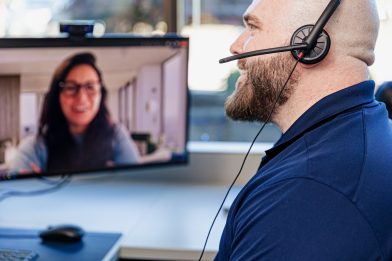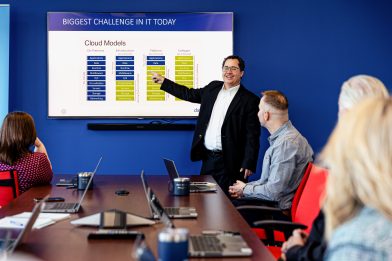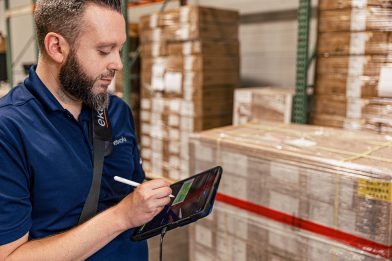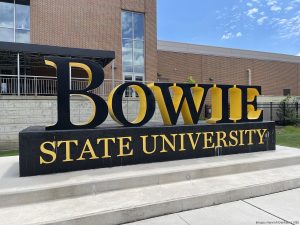The solution
Each Wi-Fi network site assessment is unique, but they all follow the same basic pattern: visiting every WAP comprising a Wi-Fi network, using a device to collect data from individual WAPs, and organizing all the collected data into an understandable analysis that engineers and clients use to identify every WAP’s strengths and weaknesses. In Data Networks’ case, engineers are trained to use and have extensive practical experience with the Ekahau Site Survey Platform, arguably the world’s site assessment tool of choice.
To begin the data collection phase of the project, Data Networks engineers set up the Ekahau Sidekick 2 appliance. The Sidekick 2 connects to an Apple iPad, onto which a scale map of the Bowie campus was loaded. They then integrated this map with Apple iOS’s augmented reality built into the iPad, so that walls, doors, and other structures could be seen while visiting a specific WAP. To collect WAP data, a Data Networks engineer simply held the Sidekick 2 appliance while pointing the iPad camera outward to record the data. The engineer then walked the area with the device. Knowing where the WAPs are based on the map, Sidekick 2 collected an enormous amount of data within the area. Collected data included broadcast channels, frequencies, signal strengths, noise floors, and many other attributes. The engineer repeated this each day during the data collection phase until all data was collected from all WAPs within the university’s Wi-Fi network.
From there, Data Networks engineers shifted their focus to the project’s analysis phase. The Ekahau device includes a reporting function that produces two types of data per WAP: general characteristics of the WAP, and specific attributes relative to precise locations covered by the WAP. Given the number of WAPs across the campus, the engineers had a significant amount of data to digest to make recommendations on the Wi-Fi network improvements to be made.
Mission accomplished
The Data Networks project team created and presented Bowie IT staff with a detailed Wi-Fi site assessment report containing results for all WAPs. In summary, the engineers’ key findings described in the report were:
- Data rates (or speeds that data travels across a Wi-Fi network) as low as six megabits per second (Mbit/s) were observed on many of the 5GB WAP areas across campus. “This is a very low data rate. When experienced by at least one user on the network, data rates this low drag all other users – even those with devices capable of much better performance – down to that level,” says Hilburn. Data Networks engineers determined this to be a leading root cause of the reported widespread poor user experiences. In the report, the engineers recommended that IT staff increase all WAP minimum data rates to at least 12 Mbit/s, and preferably 24 Mbit/s.
- Interfering devices were a big problem. Data Networks engineers discovered quite a lot of them all over the university’s Wi-Fi network. These devices included printers, medical beds in the nursing school, audiovisual equipment in the performing arts center, and more. These devices unknowingly had Wi-Fi turned on by default or otherwise and were broadcasting on the same channels as the university’s production Wi-Fi network, causing considerable interference and contributing to the lack of connectivity and poor performance reported by end users. In their report, Data Networks engineers identified every interfering device by name and type, enabling Bowie IT staff to power off or adjust each device’s Wi-Fi settings as needed to significantly improve network performance.
- Data Networks’ reporting included a vulnerability assessment of the university’s Wi-Fi network. They found several risks inherent in device configurations and provided university IT staff with specific recommendations to mitigate those risks.
“The fruits of our partnership with Data Networks will enable Bowie to make data-driven decisions to improve the overall posture of our wireless network for our constituents.”
-Maurice Tyler, Vice President for Information Technology and Chief Information Officer
The project’s outcome underscores Data Networks’ expertise and capability around Wi-Fi network assessments and solutions. According to Maurice Tyler, Bowie’s Vice President for Information Technology and Chief Information Officer, “The fruits of our partnership with Data Networks will enable Bowie to make data-driven decisions to improve the overall posture of our wireless network for our constituents.” As Hilburn puts it, “All Data Networks engineers need to know from a client is that there’s a problem, and we use our brainpower and our toolset to pinpoint the exact problem and recommend the correct fixes.”







